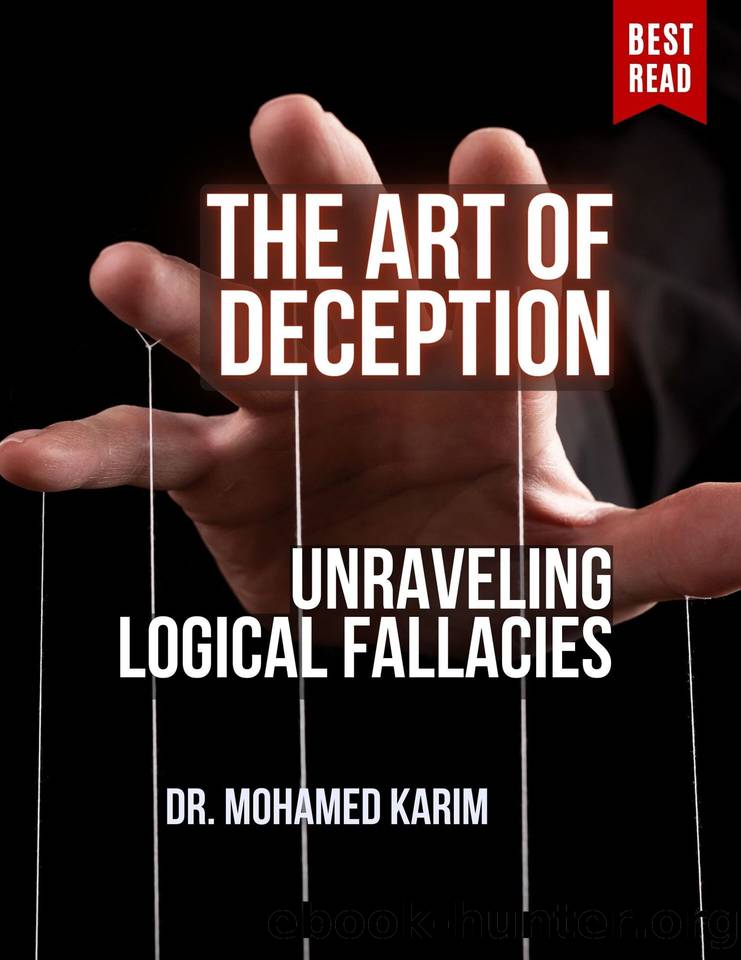The Art of Deception: Unraveling Logical Fallacies by Karim Mohamed

Author:Karim, Mohamed
Language: eng
Format: epub
Publisher: Mohamed Karim
Published: 2023-12-29T00:00:00+00:00
Chapter 12: Post Hoc Fallacy
The Post Hoc Fallacy, short for "Post Hoc Ergo Propter Hoc," is a logical fallacy that occurs when it is assumed that because one event followed another, the first event caused the second. This fallacy can lead to incorrect conclusions, as it confuses sequence with causation. Understanding the Post Hoc Fallacy is crucial in various fields, from science to everyday reasoning, to avoid drawing unwarranted connections between events. This chapter explores the Post Hoc Fallacy, illustrated through real-life examples.
Understanding the Post Hoc Fallacy:
Sequence Misinterpreted as Causation: Mistaking the chronological order of events as evidence of a causal relationship.
Overlooking Other Factors: Ignoring other potential causes or factors that could have contributed to the observed outcome.
Simplifying Complex Relationships: Oversimplifying complex situations where multiple variables are involved.
Real-Life Examples and Analysis:
In Medical Treatment:
Example: A patient recovers from a cold after taking a homeopathic remedy and concludes that the remedy cured them.
Analysis: This is a Post Hoc Fallacy, as the patient assumes causation based on the timing of events. The recovery could be due to the bodyâs natural healing process or other factors, not necessarily the remedy.
In Sports Superstitions:
Example: A basketball player wears a particular pair of socks and plays exceptionally well in a game, leading them to believe that the socks bring good luck.
Analysis: Believing the socks caused the good performance is an example of the Post Hoc Fallacy. The playerâs performance could be influenced by practice, skill, or other circumstances, not the socks.
In Economic Policies: Example: A government implements a new economic policy, and shortly after, the country's unemployment rate decreases. The policy is then credited as the cause of the improvement. Analysis: This could be a Post Hoc Fallacy if the decrease in unemployment is attributed solely to the policy without considering other economic factors or trends that may have contributed.
In Environmental Changes:
Example: After a year with a high number of forest fires, a new fire-fighting strategy is implemented. The following year, the number of fires decreases, and the strategy is deemed a success.
Analysis: This may be a Post Hoc Fallacy if the decrease is solely attributed to the new strategy without considering other variables, such as weather changes or natural variability.
Conclusion:
The Post Hoc Fallacy highlights the danger of jumping to conclusions based on the sequence of events without adequate evidence of causation. It underscores the importance of considering multiple factors and conducting thorough analysis before determining cause-and-effect relationships. Recognizing this fallacy is essential in developing a more critical and analytical approach to understanding the world, avoiding simplistic explanations for complex phenomena.
Section 12.1: Explaining Post Hoc Ergo Propter Hoc
"Post Hoc Ergo Propter Hoc," a Latin phrase meaning "after this, therefore because of this," is a logical fallacy that occurs when one assumes that because one event followed another, the first event caused the second. This fallacy is a common error in reasoning as it mistakes correlation for causation. This section delves into the explanation of the Post Hoc fallacy, supplemented by real-life examples.
Characteristics of the Post Hoc Fallacy:
Mistaking Temporal Sequence for Causality: Assuming that if Event A precedes Event B, A must have caused B.
Download
This site does not store any files on its server. We only index and link to content provided by other sites. Please contact the content providers to delete copyright contents if any and email us, we'll remove relevant links or contents immediately.
The remains of the day by Kazuo Ishiguro(7583)
Tools of Titans by Timothy Ferriss(6974)
The Black Swan by Nassim Nicholas Taleb(6209)
Inner Engineering: A Yogi's Guide to Joy by Sadhguru(5919)
Giovanni's Room by James Baldwin(5899)
The Way of Zen by Alan W. Watts(5814)
The Six Wives Of Henry VIII (WOMEN IN HISTORY) by Fraser Antonia(4801)
The Power of Now: A Guide to Spiritual Enlightenment by Eckhart Tolle(4777)
Astrophysics for People in a Hurry by Neil DeGrasse Tyson(4631)
Asking the Right Questions: A Guide to Critical Thinking by M. Neil Browne & Stuart M. Keeley(4608)
12 Rules for Life by Jordan B. Peterson(3758)
The Ethical Slut by Janet W. Hardy(3519)
Skin in the Game by Nassim Nicholas Taleb(3488)
Housekeeping by Marilynne Robinson(3427)
The Art of Happiness by The Dalai Lama(3394)
Double Down (Diary of a Wimpy Kid Book 11) by Jeff Kinney(3289)
Skin in the Game: Hidden Asymmetries in Daily Life by Nassim Nicholas Taleb(3278)
Walking by Henry David Thoreau(3240)
12 Rules for Life: An Antidote to Chaos by Jordan B. Peterson(3211)
